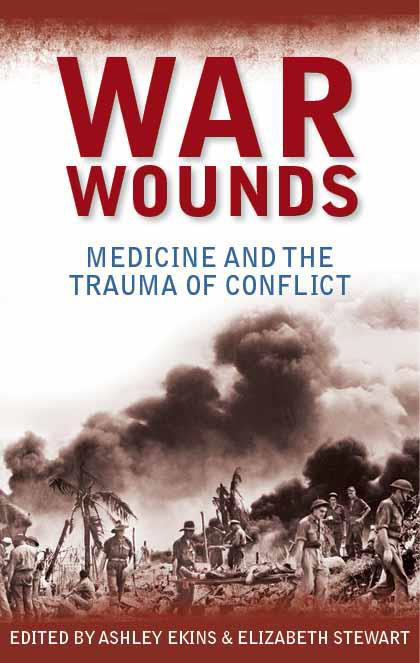An international conference War Wounds: Medicine of Trauma and Conflict was conceived by Ashley Atkins and with his colleague Elizabeth Stewart developed the program that was convened by the Australian War Memorial in September 2009 with the support of the Department of Veteran Affairs.
This book contains presentations by the Keynote Speaker Professor Jay Winter, Professor of History at Yale, the co-editors, and those who presented on a wide range of topics covering death and injury in military conflict over the past century.
Acknowledgement is made of the huge medical advances during all these conflicts that has resulted in remarkable decreases in deaths, amputations and enhanced the rehabilitation of survivors. Following a comprehensive introduction by Stewart, the work covers, in chronological order: World Wars, Korea, Vietnam and Afghanistan conflicts; as well as how two severely disabled Vietnam veterans are now coping with their war legacies.
The comprehensive Notes on Contributors give the reader an insight to the diverse approaches in the chapters that follow. The term ’shell shock’ appears in the opening chapter, and then follows accounts of soldiers who resorted to self-inflicted wounds in order to escape the trauma of the Western Front. The impact of gunshot wounds to the head causing permanent disfigurement and the advancements made in their treatment and facial reconstruction (the beginnings of today’s plastic surgery) is comprehensively discussed. Those who enlisted to fight the Great War and returned with physical and mental disabilities were placed back in their home to be cared for by their family. There are scant statistical records of the numbers who were ‘fobbed off’ by the Repatriation Department, and even less information on how their families managed, in many instances well into the 1930s.
The two papers on World War II cover the SS military experiments on concentration- camp prisoners – some having survived into the 21st century; and a disheartening account of the totally unpreparedness of the Allies to cope with the condition of the inhumanely treated inmates who they liberated from the camps in 1945.
The extreme conditions encountered in Korea and the difficulties they threw up in terms of soldiers’ day-to-day existence, and the treatment and evacuation of wounded are well documented by a (then) young Medical Corps doctor. Three aspects of the Vietnam War are covered by four chapters: sexually transmitted infections among Australian soldiers, the operation of surgical teams, and ‘Agent Orange’ from both the veterans’ and historians perspectives.
The final three chapters are personal accounts: by an RMO when 5RARs B Company suffered very heavy casualties in February 1967 in a Vietnam minefield, a military nurse in 2008 Afghanistan, and the incredible inspirational Graham Edwards (former MP, now retired) of life after losing both legs to a M16 mine in Vietnam in 1970.
War Wounds is a work that will interest both medical and military personnel and the general public as well. It is a very easy read, with some fascinating data included among appropriate photographs. The text is well rounded out by the inclusion of comprehensive Notes and a very detailed index.
Reviewed for RUSI by Neville Taylor, February 2016

Hardback RRP: $49.99
Contact Royal United Services Institute about this article.






